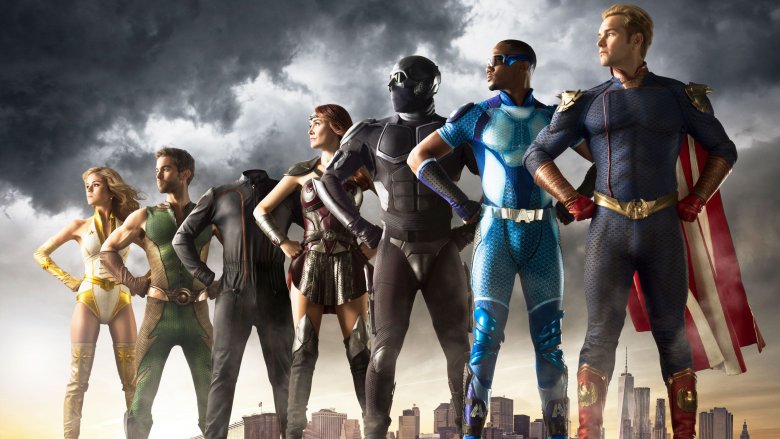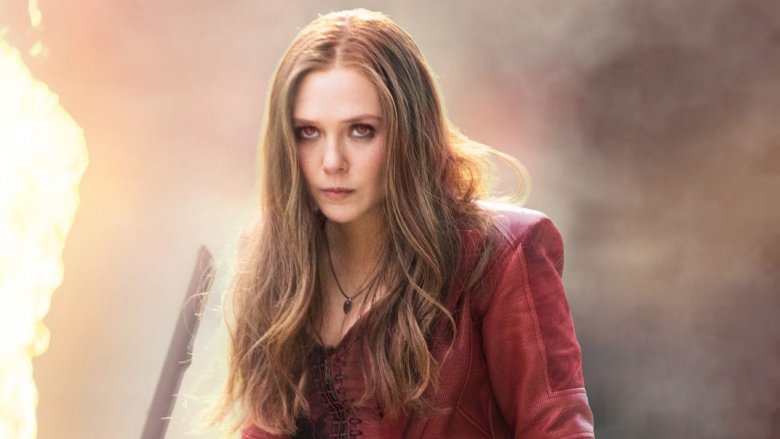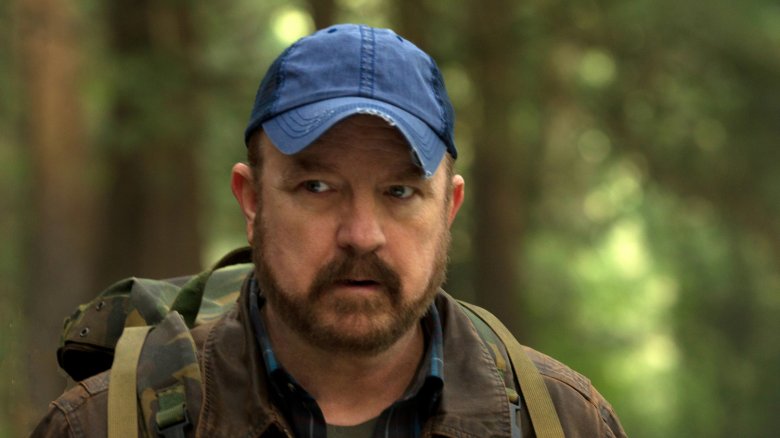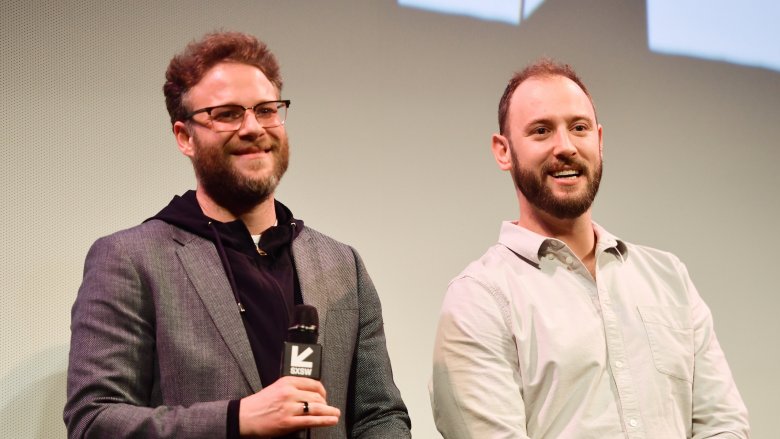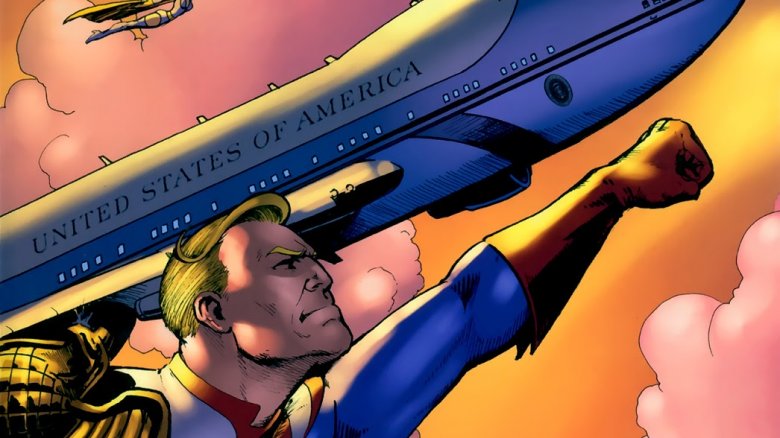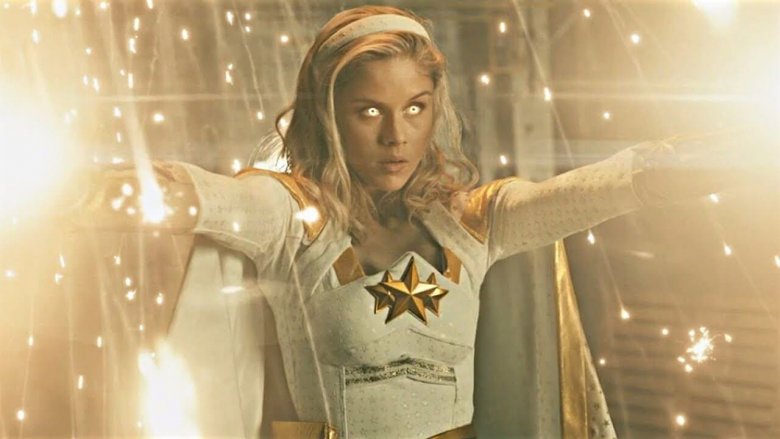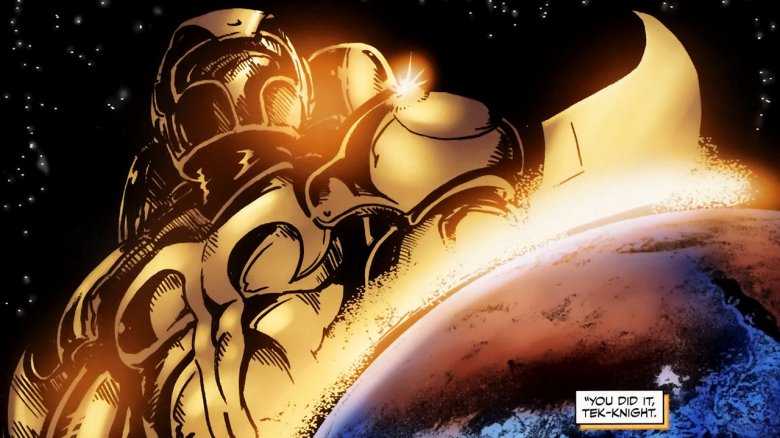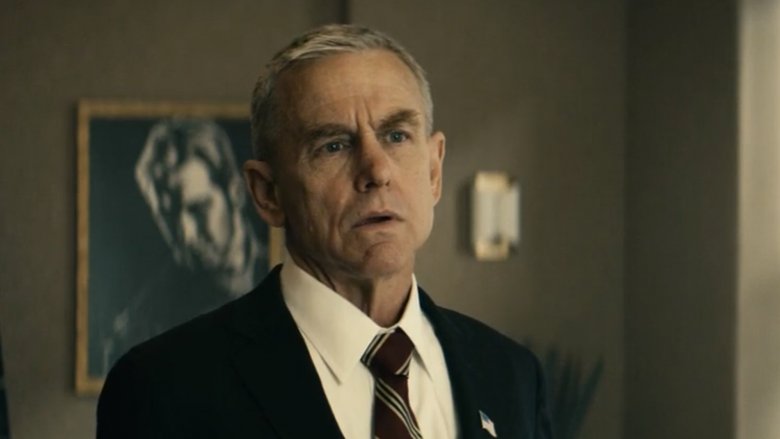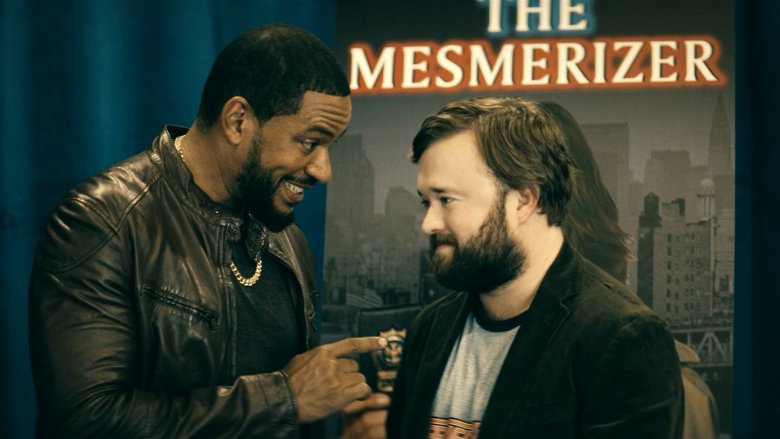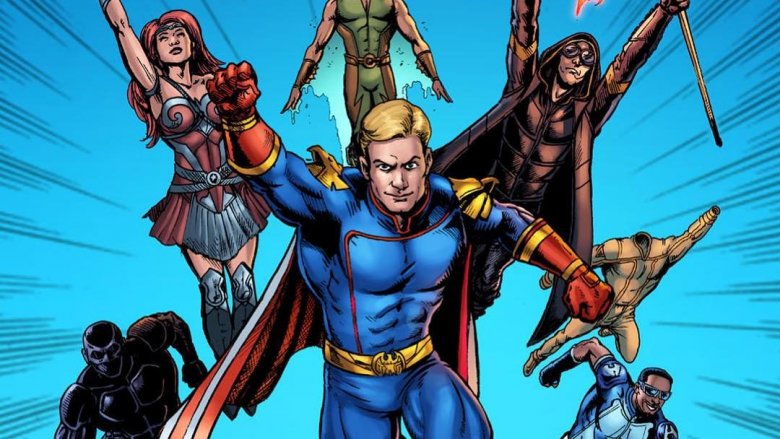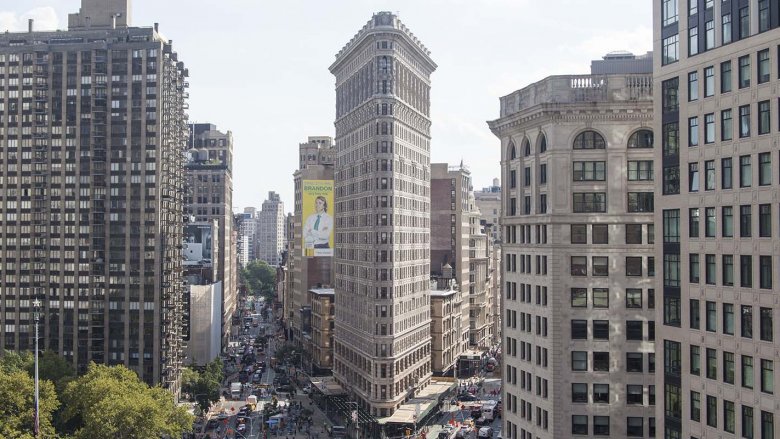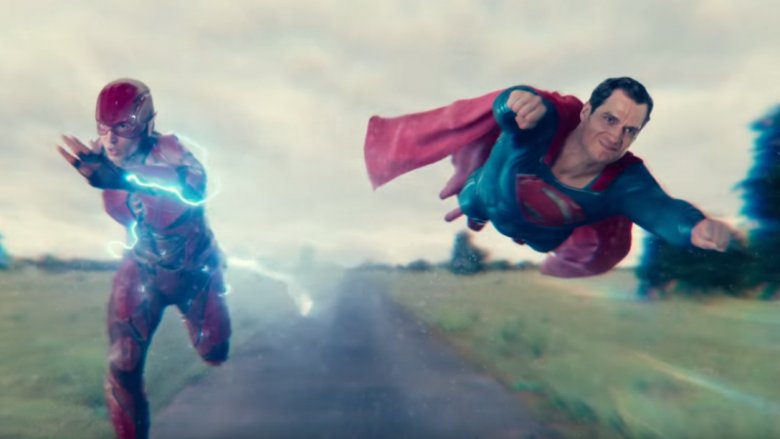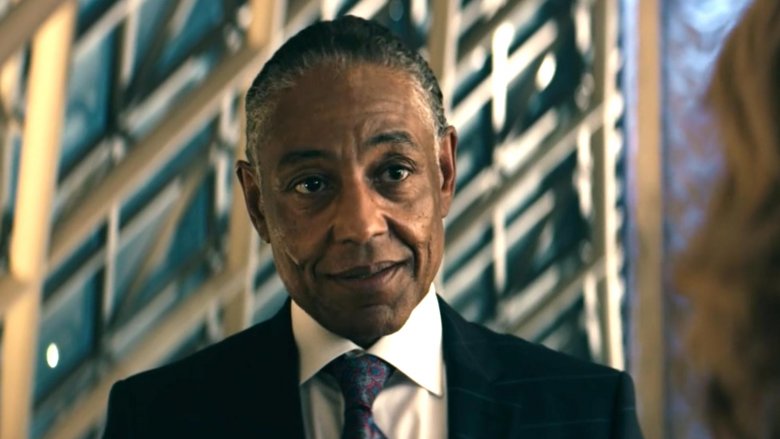Small Details Only True Fans Noticed In Amazon's The Boys
Amazon has found great success in transforming beloved books and comics into ultra-bingeable original series, and the studio really hit the jackpot with Garth Ennis and Darick Robertson's The Boys comics. The series has met widespread acclaim for its unique take on the superhero genre, with the show's release coming at the tail end of years and years of superhero films dominating the box office. Forget the MCU. Let's talk about the Vought Cinematic Universe.
The Boys constantly pokes fun at the world's infatuation with superheroes and has some not-so-subtle references to both Marvel and DC throughout the show. Fans with keen eyes and ears quickly discovered that The Boys is unafraid of getting meta, making quick but clever digs at the heroes we've become familiar with through a decade of films. The show's writing openly calls out cliches and effectively turns everything we know about superheroes on its head. Nothing is sacred in this graphic, often raunchy Amazon original. And we love it. From MCU potshots to Justice League shout-outs, here are small details that only true fans noticed about Amazon's The Boys.
The Crimson Countess is basically Scarlet Witch
It doesn't take long to get familiar with the superheroes or "supes" in the world of The Boys, because we already know them. The production is counting on the fact that its audience is already familiar with the slew of superheroes that have quickly become mainstream over the past few years. Thus, many of the supes need no introduction or explanation. We know that Homelander is a Superman clone, the Deep is this world's Aquaman, and Queen Maeve is Wonder Woman. Vought's the Seven are just DC's Justice League. So where are the Avengers?
They're there, we learn, through a quick quip from Starlight. In episode one, Starlight worries that the Crimson Countess got the open position in the Seven rather than her. The Crimson Countess is a riff on Scarlet Witch, a member of the Avengers-esque superhero team called Payback. We'll likely get a look at The Boys' mightiest heroes come season two.
Fans will definitely notice the Supernatural reference
Producer Eric Kripke likes to marry comedy to horror, slapstick to drama. This expert weaving of action with witty one liners can been seen throughout the various shows that he's produced, namely Supernatural and The Boys. Both of these shows feature memorable tough guys taking on supernaturally-powered peoples. They also both feature a character named Robert Singer, played by Jim Beaver.
Jim Beaver has been a part of each and every production that Kripke has had his hand in. Who can resist that ginger beard, after all? In Supernatural, Beaver plays fan favorite character Bobby Singer, a cantankerous old hunter of demons, ghouls, and vampires, with a fatherly influence on the show's wayward main characters. In The Boys, Beaver appears in the final episode of season one as the secretary of defense, also named Robert Singer, as if his appearance alone wasn't enough of a nod to his previous role in a Kripke hit show.
Seth and Evan from marketing are Seth and Evan from production
The Boys reveals that superhero business functions a lot more like show business. Supes aren't vigilantes dedicated to justice. Instead, they're highly managed talent akin to Hollywood actors. They just happen to also have the ability to fly or punch through walls. The company Vought doesn't allow them to choose where they patrol, who they save, or even what they wear. All that is handled by an expert team of marketers who look to statistics, social media, and stocks in deciding what moves to make.
In episode three, Starlight is given a new costume by Vought that is a little more revealing than what she's comfortable with. So Vought VP Madelyn Stillwell brings in Seth and Evan from marketing to try to sell her on the plunging neckline. These names are likely purposeful nods to the big names behind The Boys: executive producers Seth Rogen and Evan Goldberg. Seth from marketing makes a later appearance in the show, and so does Seth Rogen himself in a promotion for the latest film in the VCU.
That 'Impure Thoughts' poster is a comic book cover
In episode five, Starlight attends the Believe Expo, a festival dedicated to Christianity and superheroes. She used to attend the Expo all the time when she was younger, but now that she's older, she starts noticing that some of the messages preached there make her uncomfortable. At a round table with teens, she's told to lie and say that she's a virgin. She remembers it as a positive place, but now, she's seeing intolerant signs that encourage attendees to "pray the gay away." One that reads "Impure thoughts? Fly straight!" even features Homelander himself.
This poster, positioned in front of other anti-gay propaganda, is actually one of the covers of a The Boys spinoff called Herogasm. On the cover of issue four, we see Homelander "flying straight" alongside Air Force One. Observing all this leads to Starlight making an enraged speech on the main stage, denouncing the message of the Expo and revealing the fact that she was sexually assaulted.
Fans will spot Kripke's tweet about Starlight's speech
Starlight was, well, starry-eyed about the Seven. It had always been her dream to become a superhero, something she worked toward all her life. She, like many others, admired superheroes like Queen Maeve and the Deep for their heroics and altruism. She quickly and unfortunately learned that these shining personalities had been manufactured by Vought and that supes can be deeply, deeply flawed.
Upon her first time in the Seven's own not-so-secret sanctum, she's sexually assaulted by the Deep, who uses his position to keep her quiet. Starlight snaps at the Believe Expo, telling the world what happened to her. This led to the show's version of a #MeToo moment, with people taking to social media like Twitter to express their support for her. News reports showed scrolls of tweets with the hashtag #IStandWithStarlight. And one Twitter account should stand out to eagle-eyed viewers. Producer Eric Kripke apparently stands with Starlight, as his faux tweet is featured alongside others.
Tek-Knight is Iron Man-ish
We learn in episode six that Hughie wasn't the only person adversely affected by the superpowers of supes, as Billy Butcher brings him to an Association of Collateral Damage Survivors meeting. In a setup that looks a lot like an Alcoholics Anonymous meeting, survivors recount their rescues-gone-wrong and bad encounters with supes. The wheelchair-bound woman talking as they come in says that she wishes that Tek-Knight would've been a little more gentle with her spine.
In the comics (and maybe in The Boys season two), Tek-Knight is a kind of mashup between Batman and Iron Man. He has a mansion, a butler, and a secret cave. However, he also flies around in a super-powered metal suit and has an uncontrollable libido that causes chaos for Team Payback. When it comes to this survivor of collateral damage, it's possible that this is a dark reference to what happened with Rhodey in the MCU, as he was shot out of the sky and crippled in Captain America: Civil War, leading to him wearing high-tech leg braces. And sure, Vision is the one who shot Rhodey down, but ultimately, it was all Iron Man's fault.
The Boys gives a shout-out to the artists
Superheroes are super powerful, so why not put them in the military? In The Boys, Vought is lobbying hard to allow for supes to serve in the armed forces, and we see VP Stillwell in episode two trying to convince Senator Calhoun at a bougie event for Samaritan's Embrace, a charity that the company supports. We see some of the Seven schmoozing it up with other members of congress, but Stillwell has trouble convincing Senator Calhoun that superheroes belong in the military.
The senator points out that two other congressmen, Robertson and McCrea, are also unlikely to support this proposal. These names aren't random. They are in fact shout-outs to the original artists behind The Boys comics, Darick Robertson and John McCrea. Art from the comics, penned by their hands, is featured in the background throughout the series as posters, promotional material, and other little Easter eggs. This nod acknowledges their powerful place in the world of The Boys.
The Boys takes aim at child actors
In episode six of The Boys, we learn that not all superheroes are super famous. Some can be just as washed up as any old actor. For example, Mother's Milk goes to the "Heroes and Headliners" autograph show at the American Adventures Inn in order to seek out Charles, who's better known as Mesmer. Mesmer has the power to read someone's mind just by touching them, but his days of stardom are long gone. He was a child actor on an old show called The Mesmerizer, in which he read the minds of criminals. The Mesmerizer looks an awful lot like Law & Order with it's red and blue color scheme, but it also riffs openly on the show that gave Neil Patrick Harris his start — Doogie Howser, M.D., in which he played a kid doctor. (Of course, Mesmer's character name in The Mesmerizer was Lieutenant Howser rather than Doctor Howser.) It's notable, too, that the character of Mesmer is portrayed by Haley Joel Osment, who's best known for the roles he played as a child.
The show has been riffing on Marvel from the start
Throughout the show, The Boys mercilessly riffs on Marvel, making the nearly omnipotent company Vought play the role of Disney's powerhouse superhero studio. In the series, superheroes star in dramatic movies that supposedly reenact their most exciting adventures so that everyone can get in on the action (and so that Vought can make a killing at the box office). Thus, we have the aptly dubbed VCU — the Vought Cinematic Universe. And just in case the audience hasn't made the connection yet, Vought Studios makes a clear callback to Marvel.
In fact, the very first shot of the series has a comic book-style image of the Seven — heroic Homelander front and center — becoming a part of a bigger mosaic of the Seven. This is the Vought Studios logo, which is a mash-up of Marvel's and DC's own studio logos. The Marvel logo is made up of scenes from the films, and the DC logo ends with its heroes majestically standing, presumably against the forces of evil. This callback was just the first of many to the "real life" superheroes we know from film and comics.
The Boys HQ is actually the Daily Bugle
In episode six, Billy Butcher takes all the dirt he and the Boys have dug up about Vought to Susan Raynor, the deputy director of the CIA. With proof of Vought creating superheroes with Compound V, the government would be able to move against the company which has, so far, proven to be practically untouchable. Butcher doesn't give over all this evidence out of the goodness of his heart, however. He wants revenge ... along with a few other demands.
The Boys are currently operating on a shoestring budget, so not only does Butcher want funding and official CIA clearance, but he also believes that his ragtag team should have a not-so-secret sanctum of their own, just like the Seven. Specifically, he has the Flatiron Building in mind. This is where the Boys HQ is located in the comics, and it's a location with a lot of comic book history. It just so happens to be the Daily Bugle's building in the Sam Raimi Spider-Man films. So yeah, just picture Billy Butcher in J. Jonah Jameson's office, laughing at wee Hughie.
Comic book fans will definitely notice the racing reference
In episode three of The Boys, we learn who the fastest man alive really is. Sort of. Rumors had been going around that Shockwave was actually faster than the Seven's A-Train, whose only power is speed. But when the two race, A-Train ultimately cheats by using a performance-enhancing super drug, because being slower than Shockwave would mean that his place in the Seven would come into question. After all, why would the best of the best have the second fastest man alive?
This amazing race is a reference to the many races that the Flash and Superman would have in the comics to see who was truly the speediest speedster. Most recently, this friendly rivalry was featured as an after credits scene in the Justice League movie, with the Flash and Superman getting ready to race to the coast. In the film, Superman jokes that if he wins, then the Flash is off the team. Cue the nervous laughter. Of course, this would've been the reality if A-Train had lost to Shockwave in The Boys.
Going to Belize and the Breaking Bad connection
For much of the series, we see Vought's vice president Madelyn Stillwell making all the calls when it comes to the Seven and the other superheroes the company manages. Vought's president, known only as Mr. Edgar, remains mysterious until the final episode of season one. It turns out that Mr. Edgar — whose first name is Stan, by the way — is played by Giancarlo Esposito, best known for his memorable role as the villain Gustavo Fring from Breaking Bad.
Mr. Edgar gives Stillwell a bonus and some new responsibilities, obviously grooming her to eventually take his place. He says that someone will have to be around to run the show when he moves to Belize. This might seem like an innocent turn of phrase, but Breaking Bad fans know better, as Walter White and Saul Goodman use "going to Belize" as code for having someone killed. Maybe this is a subtle hint that by the end of the series, the Vought president will be in the grave rather than on a sunny beach.
